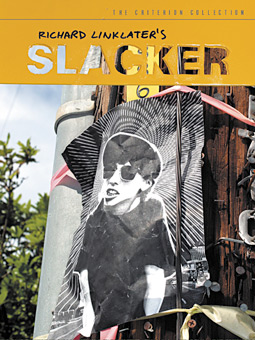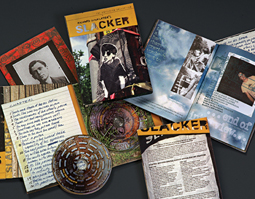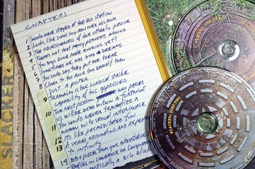5 W's by Matthew Porter
[Step Inside Design, November | December 2004]
Who
Marc English is an acquired taste. Kind of like unfiltered Camels, jalapeno peppers and tequila for breakfast. This writer first got a "taste" of English when I saw and heard him clank into a room at AIGA Austin's infamous Design Ranch wearing more metal and leather than Mad Max while performing a version of that kitsch Kuntry classic, Turkey in the Straw, that made everyone ashamed of themselves. But, like a lot of things you shouldn't have, once you've had a little snort of English, you're kind of hooked. He's the closest thing we have in AIGA to Johnny Cash. He adopted Austin as his home and milieu ten years ago and has subsumed its cultural and visual language. As a board member of the Austin Film Society English came to know writer-director Richard Linklater, creator of the cult favorite, Slacker, which was filmed in and premiered in Austin in 1991. Criterion specializes in gathering great films from around the world and publishing them in editions of high technical quality with award-winning, original supplements. The company decided to assemble such a package for Slacker's many fans. Linklater encouraged them to use English because a.) He understood Linklater b.) He understood the film and c.) He understood Austin's funky culture.
What
When asked if it was unusual to have an elaborate package design for a film that cost only about $25,000 to make, English was thoughtful: "Unusual for most, not for them [The Criterion Collection]," says English. "These are the collectible editions that get even the directors, cinematographers, writers, et cetera, excited. They put a lot into their products by adding extensive archival materials, scholarly commentaries, early shorts, shooting scripts, interviews, and essays - the works. With a portfolio of films by Truffault, Kurosawa, Fellini, Fassbinder, Bergman, Scorsese, Bunuel - a who's who of great directors - they have to fashion packages that reflect that level of greatness. Sure, it's a movie about slackers but it is also the first low-budget indie to make a huge impact on American film - it was a standard bearer. The design had to capture the essence of that history and the rich, odd personality of the film itself."
Where
Slacker was filmed in Austin, Texas. Richard Linklater, as well as Marc English, live and work in the city today. In looking for material to use in the design, English - as principal photographer - and his assistant, Bart Kibbe roamed the streets of Austin over several days, seeing how the environment could be used as a design element. In the film, the setting plays the role of a principal actor (there are 100+ different, interrelated characters featured in the film). In the design, Austin doesn't simply become the backdrop - it becomes the star.
How
The studio created custom art for every on-screen menu, utilizing appropriate materials (duct tape, cardboard, labels, flyers, dirty plates, spray paint, guitar cases, corrugated tin), which required more production effort on the part of client Criterion, than designing the standard formatted template. English used a CANON EOS-D60 digital to shoot much of the art (archive materials were supplied by the director) and used a raw, hand-cut foam stencil to make the logotype, even spraying it on the asphalt behind his office. The famous "Pap Smear Pusher" (this woman tries to sell Madonna's pap smear tab and a sample pubic hair in the film and her image was used in the film's original one sheets, etc.) was printed off at the office, wrinkled, sprayed with water, then dried and affixed to a telephone pole. Viola! Instant indie fake guerrilla marketing promo.
When
As mentioned, the film debuted in 1991 and saw a short but successful run in art house theatres from New York to Los Angeles. Shortly after it, other low-budget indie films began to capture the imagination of film enthusiasts and the interest of distributors. English, with his assistants, Bart Kibbe and Michael Nowlin, shot all the art that appears in the on-screen menus, the DVD sleeve, the 68-page book and the DVD disc faces on several scorching June days this summer. The Criterion Collection released the package for sale in September of 2004.
Why
English explains it best: "The film is a cult fave, and has been since its release. Add to that the film geeks, cineastes and filmmakers, and you've got a crowd. I would think that as writers have certain books on their shelves, musicians certain albums, filmmakers would have this as reference. As for the concept for the packaging, Linklater's films are known for their writing, their words, how people interact. It was a no-brainer to litter the book with lines from the film, sometimes randomly, sometimes in conjunction with specific art. One could argue that you could step into the film at any point, as there is no plot. Same goes for every aspect of this project - they are part of a whole, but each can exist on its own."




 7Bar Aviation
7Bar Aviation AFS | Austin Film Society
AFS | Austin Film Society AFS | Austin Studios
AFS | Austin Studios AFS | Quentin Tarantino Film Fest
AFS | Quentin Tarantino Film Fest AFS | Slacker 2011
AFS | Slacker 2011 AFS | Texas Film Hall of Fame 09
AFS | Texas Film Hall of Fame 09 AIGA | Design Ranch
AIGA | Design Ranch AMF | Love Austin Music
AMF | Love Austin Music Acran
Acran Alereon
Alereon Alliance Abroad Group
Alliance Abroad Group Arc Reps
Arc Reps Austin Museum of Art Guild
Austin Museum of Art Guild Cambridge Friends School
Cambridge Friends School GirlStart
GirlStart H2Hos
H2Hos Internet Police Alliance
Internet Police Alliance KIRK
KIRK Kinsei
Kinsei La Sonrisa Productions | Inside The Circle
La Sonrisa Productions | Inside The Circle Lake Hills Church
Lake Hills Church MARK Skateboards
MARK Skateboards Marc English Design | Since 1993
Marc English Design | Since 1993 Mass. Association of Bank Council
Mass. Association of Bank Council Mountain Crossings at Walasi-Yi
Mountain Crossings at Walasi-Yi Rancho Pancho
Rancho Pancho Sharing Technologies
Sharing Technologies Texas Film & Cattle Co.
Texas Film & Cattle Co. Texas Motion Picture Alliance
Texas Motion Picture Alliance Texas Writers Month
Texas Writers Month Thokozani
Thokozani Trails to Growth
Trails to Growth Troublemaker Studios
Troublemaker Studios Tsogolo La Thanzi Centre
Tsogolo La Thanzi Centre UT/Austin | School of Architecture
UT/Austin | School of Architecture Unnatural Axe
Unnatural Axe Wright Legal
Wright Legal ABC-TV | Healthy Start / Healthy Babies
ABC-TV | Healthy Start / Healthy Babies ACADIA: Suicide, Sex & Success
ACADIA: Suicide, Sex & Success AFS | 20th Retrospective
AFS | 20th Retrospective AFS | Essential Cinema
AFS | Essential Cinema AIGA Atlanta
AIGA Atlanta AIGA Austin | Love | Work
AIGA Austin | Love | Work AIGA Baltimore
AIGA Baltimore AIGA Birmingham
AIGA Birmingham  AIGA Boston | Touch of Power
AIGA Boston | Touch of Power AIGA Charlotte
AIGA Charlotte  AIGA Honolulu
AIGA Honolulu AIGA Houston | Doug Sahm
AIGA Houston | Doug Sahm AIGA Iowa | Fertilizing Minds
AIGA Iowa | Fertilizing Minds AIGA Las Vegas
AIGA Las Vegas AIGA Miami
AIGA Miami AIGA Nashville
AIGA Nashville  AIGA Omaha | The Wolves of Texas
AIGA Omaha | The Wolves of Texas AIGA Philadelphia
AIGA Philadelphia AIGA Washington, D.C.
AIGA Washington, D.C.  Angels You Left
Angels You Left Art Directors Club of Tulsa
Art Directors Club of Tulsa Auburn University
Auburn University BF/VF | Laurie Anderson
BF/VF | Laurie Anderson BF/VF | MIra Nair
BF/VF | MIra Nair Green Room Pictures
Green Room Pictures HOW Design Conference 2007
HOW Design Conference 2007 La Sonrisa Productions | Inside the Circle
La Sonrisa Productions | Inside the Circle Manufacturing Dissent
Manufacturing Dissent NWAADC Perspective
NWAADC Perspective NWAADC Step No. 3: O.B.E.
NWAADC Step No. 3: O.B.E. Quinto Malo Films | One Minute to Nine
Quinto Malo Films | One Minute to Nine Ransom Center | Avant Garde Film
Ransom Center | Avant Garde Film Ransom Center | Brit Noir
Ransom Center | Brit Noir Ransom Center | Voyages
Ransom Center | Voyages Texas Film Hall of Fame
Texas Film Hall of Fame Texas Writers Month | 1997 | O. Henry
Texas Writers Month | 1997 | O. Henry Texas Writers Month | 1998 | Porter
Texas Writers Month | 1998 | Porter Texas Writers Month | 1999 | McMurtry
Texas Writers Month | 1999 | McMurtry Texas Writers Month | 2000 | McCarthy
Texas Writers Month | 2000 | McCarthy Texas Writers Month | 2001 | Kelton
Texas Writers Month | 2001 | Kelton Texas Writers Month | 2002 | Carpenter
Texas Writers Month | 2002 | Carpenter Texas Writers Month | 2003 | Dobie
Texas Writers Month | 2003 | Dobie Texas Writers Month | 2004 | Michener
Texas Writers Month | 2004 | Michener Criterion | Border Radio
Criterion | Border Radio Criterion | Dazed and Confused
Criterion | Dazed and Confused Criterion | My Own Private Idaho
Criterion | My Own Private Idaho Criterion | Naked
Criterion | Naked Criterion | Slacker
Criterion | Slacker Criterion | Two-Lane Blacktop
Criterion | Two-Lane Blacktop Criterion | Walker
Criterion | Walker Honora Jacob
Honora Jacob Internet Police Alliance
Internet Police Alliance Kinsei
Kinsei Legacy Trails
Legacy Trails MARK Skateboards | website
MARK Skateboards | website Site59
Site59 AFS | 20th Retrospective
AFS | 20th Retrospective AFS | Austin Studios brochure
AFS | Austin Studios brochure AFS | Texas Film Hall of Fame
AFS | Texas Film Hall of Fame Austin Chronicle | English: 2nd Language
Austin Chronicle | English: 2nd Language Austin Film Society | PoV
Austin Film Society | PoV Austin Museum of Art Guild
Austin Museum of Art Guild Chronicle Books | Cooking Up A Storm
Chronicle Books | Cooking Up A Storm Chronicle Books | Where Flavor Was Born
Chronicle Books | Where Flavor Was Born City of Austin | Create Austin Cultural Plan
City of Austin | Create Austin Cultural Plan Four Hands
Four Hands Houghton Mifflin | About Language
Houghton Mifflin | About Language Indigenous Art of Coahuila
Indigenous Art of Coahuila Inspirational Hollywood
Inspirational Hollywood Massachusetts College of Art | Compton
Massachusetts College of Art | Compton Meta Design
Meta Design Rockport Publishers | Designing Identity
Rockport Publishers | Designing Identity Texas Fine Art Association | Pulp Fictions
Texas Fine Art Association | Pulp Fictions Texas Fine Arts Association
Texas Fine Arts Association Texas Writers Month
Texas Writers Month The Art of Beowulf
The Art of Beowulf UT Department of Education
UT Department of Education UTSoA | Planning Forum
UTSoA | Planning Forum Vtel
Vtel Xetel Corporation
Xetel Corporation  AFS | Essential Cinema
AFS | Essential Cinema AFS | Fundraising Invitation
AFS | Fundraising Invitation AFS | Make Watch Love Film
AFS | Make Watch Love Film Arts Alliance America | Inning By Inning
Arts Alliance America | Inning By Inning Booker Music | Craig Hella Johnson
Booker Music | Craig Hella Johnson  Boston Brownies
Boston Brownies Criterion | Border Radio
Criterion | Border Radio Criterion | Dazed and Confused
Criterion | Dazed and Confused Criterion | Naked
Criterion | Naked Criterion | Slacker
Criterion | Slacker Criterion | Two-Lane Blacktop
Criterion | Two-Lane Blacktop Criterion | Walker
Criterion | Walker Dr. Dreams Juice Machine
Dr. Dreams Juice Machine LOL
LOL La Peste
La Peste MARK Skateboards | decks
MARK Skateboards | decks Merchants of Venus
Merchants of Venus The Good Seeds
The Good Seeds  The Stains
The Stains Two Mule Records
Two Mule Records Whole Foods Market | 365 Pasta | bag
Whole Foods Market | 365 Pasta | bag Whole Foods Market | 365 Pasta | box
Whole Foods Market | 365 Pasta | box Whole Foods Market | Belgian Chocolates
Whole Foods Market | Belgian Chocolates Whole Foods Market | Pasta
Whole Foods Market | Pasta Whole Foods Market | Pasta family
Whole Foods Market | Pasta family Whole Foods Market | Seasonal Specialties
Whole Foods Market | Seasonal Specialties Whole Foods Market | Truffles
Whole Foods Market | Truffles